Impact Assessment of the Ms7.0 Earthquake on Jiuzhaigou Valley from the Perspective of Vegetation Net Primary Productivity
Abstract
:1. Introduction
- (1)
- The distribution and characteristics of NPP before and after the earthquake estimated by the CASA model were analyzed.
- (2)
- Based on the NPP results above, earthquake-induced geohazards (coseismic landslide, collapse and debris flow) identified by field survey were considered for grasping the dynamic NPP changes caused by earthquake-induced geohazards. The features of the impact of each type of geohazard on the ecosystem were preliminarily discussed.
- (3)
- In accordance with the assessment methods of Hu et al. [6], the assessment system concerning seismic intensity was constructed for quantificational analysis of the impact of the earthquake on vegetation NPP in Jiuzhaigou Valley.
2. Study Region and Methodology
2.1. Study Region
2.1.1. Overview of Jiuzhaigou Valley
2.1.2. Earthquake-Induced Geohazards
2.2. Methodology
2.2.1. Related Data and Preprocessing
2.2.2. NPP Estimated by the CASA Model
2.2.3. Quantitative Impact Calculation
3. Results and Analyses
3.1. Distribution and Characteristics of NPP
3.2. NPP Change Attributed to Geohazards
3.3. Vegetation-Earthquake Impact Assessment
4. Discussion
5. Conclusions
- (1)
- The NPP value of more than 70% area was 90–150 gC/m2 in July. In August, the value showed an overall decrease, and the areas with lower values became larger; the NPP value of most areas was 60–150 gC/m2.
- (2)
- NPPmax and NPPmean were 151.5–261.9 gC/m2 and 54.6–116.3 gC/m2, respectively, in July, August and September from 2015 to 2019. The vegetation gradually recovered after the earthquake. The NPP value showed an uptrend in the corresponding periods in 2018 and 2019. The integral decline amplitude decreased by years in comparison to that in 2015 and 2016. The decrease slowed down after the earthquake.
- (3)
- During the earthquake, compared with the NPP value in the same month in 2016, the value in areas affected by geohazards sharply declined by 27.2% (landslide), 22.4% (debris flow) and 15.7% (collapse). The vegetation in debris flow zones showed a stronger recovery, with a maximum increase of about 23.0% in September 2017.
- (4)
- In the aspect of the assessment system, the resilience index corresponding to the seismic intensity ranges one month after the earthquake was 0.642–0.693, and that of the whole study region was 0.671. The vulnerability index corresponding to the seismic intensity ranges was 0.470–0.669, and that of the whole study region was 0.473. The impact coefficient defined to represent the impact of the earthquake on NPP was 0.146–0.213.
Author Contributions
Funding
Institutional Review Board Statement
Informed Consent Statement
Data Availability Statement
Conflicts of Interest
References
- Lu, X.; Zheng, G.; Miller, C.; Miller, C.; Alvarado, E. Combining multi-Source remotely sensed data and a process-Based model for forest aboveground biomass updating. Sensors 2017, 17, 2062. [Google Scholar] [CrossRef] [PubMed] [Green Version]
- Zhao, M.; Running, S. Drought-induced reduction in global terrestrial net primary production from 2000 through 2009. Science 2010, 329, 940–943. [Google Scholar] [CrossRef] [PubMed] [Green Version]
- Wang, Y.; Fu, B.; Xu, P. Evaluation the impact of earthquake on ecosystem services. Procedia Environ. Sci. 2012, 13, 954–966. [Google Scholar] [CrossRef] [Green Version]
- Sanderson, E.; Jaiteh, M.; Levy, M.; Redford, K.; Wannebo, A.; Woolmer, G. The human footprint and the last of the wild: The human footprint is a global map of human influence on the land surface, which suggests that human beings are stewards of nature, whether we like it or not. BioScience 2002, 52, 891–904. [Google Scholar] [CrossRef] [Green Version]
- UNESCO World Heritage List. 2020. Available online: https://whc.unesco.org/en/list/ (accessed on 6 June 2020).
- Hu, X.; Hu, K.; Zhang, X.; Wei, L.; Tang, J. Quantitative assessment of the impact of earthquake-Induced geohazards on natural landscapes in Jiuzhaigou Valley. J. Mt. Sci. 2019, 16, 441–452. [Google Scholar] [CrossRef]
- Lekakis, S.; Shakya, S.; Kostakis, V. Bringing the community back: A case study of the post-earthquake heritage restoration in Kathmandu Valley. Sustainability 2018, 10, 2798. [Google Scholar] [CrossRef] [Green Version]
- Zuo, H.; Shen, H.; Dong, S.; Wu, S.; He, F.; Zhang, R.; Wang, Z.; Shi, H.; Hao, X.; Tan, Y. Effects of strong earthquake on plant species composition, diversity, and productivity of alpine grassland on Qinghai-Tibetan Plateau. Front Plant Sci. 2022, 13, 870613. [Google Scholar] [CrossRef]
- McGuire, A.; Melillo, J.; Joyce, L.; Kicklighter, D.; Grace, A.; Moore III, B.; Vorosmarty, C. Interactions between carbon and nitrogen dynamics in estimating net primary productivity for potential vegetation in North America. Glob. Biogeochem. Cycles 1992, 6, 101–124. [Google Scholar] [CrossRef] [Green Version]
- Haxeltine, A.; Prentice, I. BIOME3: An equilibrium terrestrial biosphere model based on eco-physiological constraints, resource availability, and competition among plant functional types. Glob. Biogeochem. Cycles 1996, 10, 693–709. [Google Scholar] [CrossRef]
- White, M.; Thornton, P.; Running, S.; Nemani, R. Parameterization and sensitivity analysis of the BIOME–BGC terrestrial ecosystem model: Net primary production controls. Earth Interact. 2000, 4, 1–85. [Google Scholar] [CrossRef]
- Tao, B.; Li, K.; Shao, X.; Cao, M. The temporal and spatial patterns of terrestrial net primary productivity in China. J. Geogr. Sci. 2003, 13, 163–171. [Google Scholar] [CrossRef]
- Wu, Z.; Hugelius, G.; Luo, Y.; Smith, B.; Xia, J.; Fensholt, R.; Lehsten, V.; Ahlström, A. Approaching the potential of model-data comparisons of global land carbon storage. Sci. Rep. 2019, 9, 3367. [Google Scholar] [CrossRef] [PubMed] [Green Version]
- Chen, T.; Li, P.; Liu, S.; Wang, Q. Spatio-temporal pattern of net primary productivity in hengduan mountains area, China: Impacts of climate change and human activities. Chin. Geogr. Sci. 2017, 27, 948–962. [Google Scholar] [CrossRef] [Green Version]
- Yan, Y.; Liu, X.; Ou, J.; Li, X.; Wen, Y. Assimilating multi-source remotely sensed data into a light use efficiency model for net primary productivity estimation. Int. J. Appl. Earth Obs. Geoinf. 2018, 72, 11–25. [Google Scholar] [CrossRef]
- Wieder, W.; Cleveland, C.; Smith, W.; Todd-Brown, K. Future productivity and carbon storage limited by terrestrial nutrient availability. Nat. Geosci. 2015, 8, 441–444. [Google Scholar] [CrossRef]
- Li, A.; Bian, J.; Lei, G.; Huang, C. Estimating the maximal light use efficiency for different vegetation through the CASA model combined with time-series remote sensing data and ground measurements. Remote Sens. 2012, 4, 3857–3876. [Google Scholar] [CrossRef] [Green Version]
- Tang, C.; Fu, X.; Jiang, D.; Fu, J.; Zhang, X.; Zhou, S. Simulating spatiotemporal dynamics of sichuan grassland net primary productivity using the CASA model and in situ observations. Sci. World J. 2014, 2014, 956963. [Google Scholar] [CrossRef] [Green Version]
- Wu, C.; Chen, K.E.C.; You, X.; He, D.; Hu, L.; Liu, B.; Wang, R.; Shi, Y.; Li, C.; Liu, F. Improved CASA model based on satellite remote sensing data: Simulating net primary productivity of Qinghai Lake basin alpine grassland. Geosci. Model Dev. 2022, 15, 6919–6933. [Google Scholar] [CrossRef]
- Sun, Q.; Li, B.; Zhou, C.; Li, F.; Zhang, Z.; Ding, L.; Zhang, T.; Xu, L. A systematic review of research studies on the estimation of net primary productivity in the Three-River Headwater Region, China. J. Geogr. Sci. 2017, 27, 161–182. [Google Scholar] [CrossRef]
- Nan, X.; Li, A.; Zhao, W.; Bian, J.; Jin, H.; Deng, W.; Koirala, H. Spatio-Temporal patterns of the net primary productivity in Southern Himalayas during 2001–2015. In Land Cover Change and Its Eco-Environmental Responses in Nepal; Springer Geography: Singapore, 2017. [Google Scholar] [CrossRef]
- Li, F.G.; Xin, X.Z.; Li, X.J. Assessment of restoration of vegetation net primary productivity in earthquake disaster area. Res. Soil Water Conserv. 2017, 24, 139–146. (In Chinese) [Google Scholar]
- Chen, X.; Chen, J.; Cui, P.; You, Y.; Hu, K.; Yang, Z.; Zhang, W.; Li, X.; Wu, Y. Assessment of prospective hazards resulting from the 2017 earthquake at the world heritage site Jiuzhaigou Valley, Sichuan, China. J. Mt. Sci. 2018, 15, 779–792. [Google Scholar] [CrossRef]
- Hu, X.; Hu, K.; Tang, J.; You, Y.; Wu, C. Assessment of debris-flow potential dangers in the Jiuzhaigou Valley following the August 8, 2017, Jiuzhaigou earthquake, western China. Eng. Geol. 2019, 256, 57–66. [Google Scholar] [CrossRef]
- Sevgen, E.; Kocaman, S.; Nefeslioglu, H.A.; Gokceoglu, C. A novel performance assessment approach using photogrammetric techniques for landslide susceptibility mapping with logistic regression, ANN and random forest. Sensors 2019, 19, 3940. [Google Scholar] [CrossRef] [Green Version]
- Zhu, W.; Pan, Y.; He, H.; Yu, D.; Hu, H. Simulation of the maximum light utilization efficiency of typical vegetation in China. Chin. Sci. Bull. 2006, 51, 457–463. [Google Scholar] [CrossRef]
- Yang, J.; Huang, X. The 30 m annual land cover dataset and its dynamics in China from 1990 to 2019. Earth Syst. Sci. Data 2021, 13, 3907–3925. [Google Scholar] [CrossRef]
- Potter, C.; Randerson, J.; Field, C.; Matson, P.; Vitousek, P.; Mooney, H.; Klooster, S. Terrestrial ecosystem production: A process model based on global satellite and surface data. Glob. Biogeochem. Cycles 1993, 7, 811–841. [Google Scholar] [CrossRef]
- Field, C.; Randerson, J.T.; Malmstroem, C.M. Global net primary production: Combining ecology and remote sensing. Remote Sens. Environ. 1995, 51, 74–88. [Google Scholar] [CrossRef] [Green Version]
- Thywissen, K. Core terminology of disaster reduction: A comparative glossary. In Measuring Vulnerability to Natural Hazards; Birkmann, J., Ed.; United Nations University Press: Tokyo, Japan, 2006; pp. 448–496. [Google Scholar]
- Winter, S. Forest naturalness assessment as a component of biodiversity monitoring and conservation management. Forestry 2012, 85, 293–304. [Google Scholar] [CrossRef] [Green Version]
- Zinnen, J.; Spyreas, G.; Erdős, L.; Berg, C.; Matthews, J. Expert-based measures of human impact to vegetation. Appl. Veg. Sci. 2021, 24, e12523. [Google Scholar] [CrossRef]
- Khalifa, M.; Elagib, N.; Ribbe, L.; Schneider, K. Spatio-temporal variations in climate, primary productivity and efficiency of water and carbon use of the land cover types in Sudan and Ethiopia. Sci. Total Environ. 2018, 624, 790–806. [Google Scholar] [CrossRef]
- Xue, L.; Kappas, M.; Wyss, D.; Wang, C.; Putzenlechner, B.; Thi, N.; Chen, J. Assessment of climate change and human activities on vegetation development in Northeast China. Sensors 2022, 22, 2509. [Google Scholar] [CrossRef] [PubMed]
- Berberoglu, S.; Evrendilek, F.; Ozkan, C.; Donmez, C. Modeling forest productivity using Envisat MERIS data. Sensors 2007, 7, 2115–2127. [Google Scholar] [CrossRef] [PubMed] [Green Version]
- Zhang, Y.; Hu, Q.; Zou, F. Spatio-temporal changes of vegetation net primary productivity and its driving factors on the Qinghai-Tibetan Plateau from 2001 to 2017. Remote Sens. 2021, 13, 1566. [Google Scholar] [CrossRef]
- Guo, X.; Fu, B.; Du, J.; Shi, P.; Li, J.; Li, Z.; Du, J.; Chen, Q.; Fu, H. Monitoring and assessment for the susceptibility of landslide changes after the 2017 Ms 7.0 jiuzhaigou earthquake using the remote sensing technology. Front. Earth Sci. 2021, 9, 633117. [Google Scholar] [CrossRef]
- Pasolini, C.; Gasperini, P.; Albarello, D.; Lolli, B.; D’Amico, V. The attenuation of seismic intensity in Italy, part I: Theoretical and empirical backgrounds. Bull. Seismol. Soc. Am. 2008, 98, 682–691. [Google Scholar] [CrossRef]
- Sun, J.; Yu, Y.; Li, Y. Stochastic finite-fault simulation of the 2017 Jiuzhaigou earthquake in China. Earth Planets Space 2018, 70, 128. [Google Scholar] [CrossRef] [Green Version]
- Ferrario, M.; Livio, F.; Capizzano, S.; Michetti, A. Developing the first intensity prediction equation based on the environmental scale intensity: A case study from strong normal-faulting earthquakes in the Italian Apennines. Seismol. Res. Lett. 2020, 91, 2611–2623. [Google Scholar] [CrossRef]
- Zhao, W.; You, Y.; Chen, X.; Liu, J.; Chen, J. Case study on debris-flow hazard mitigation at a world natural heritage site, Jiuzhaigou Valley, Western China. Geomat. Nat. Hazards Risk 2020, 11, 1782–1804. [Google Scholar] [CrossRef]
- Ling, S.; Sun, C.; Li, X.; Ren, Y.; Xu, J.; Huang, T. Correction to: Characterizing the distribution pattern and geologic and geomorphic controls on earthquake-triggered landslide occurrence during the 2017 Ms 7.0 Jiuzhaigou earthquake, Sichuan, China. Landslides 2021, 18, 1275–1291. [Google Scholar] [CrossRef]
- Liu, Y.; Liu, R.; Ge, Q. Evaluating the vegetation destruction and recovery of Wenchuan earthquake using MODIS data. Nat. Hazards 2010, 54, 851–862. [Google Scholar] [CrossRef]
- Zheng, Y.; Wu, B.; Zhang, M.; Zeng, H. Crop phenology detection using high spatio-temporal resolution data fused from SPOT5 and MODIS products. Sensors 2016, 16, 2099. [Google Scholar] [CrossRef] [PubMed] [Green Version]
- Wang, M.; Yang, W.; Shi, P.; Xu, C.; Liu, L. Diagnosis of vegetation recovery in mountainous regions after the Wenchuan earthquake. IEEE J. Sel. Top. Appl. Earth Obs. Remote Sens. 2014, 7, 3029–3037. [Google Scholar] [CrossRef]
- Kang, D.; Zou, S.; Ma, L.; Yin, C.; Zhu, D. Abiotic regulation: Landslide scale and altitude regulate functional traits of regenerating plant communities after earthquakes. Front. Ecol. Evol. 2022, 10, 846642. [Google Scholar] [CrossRef]
- Wu, C.; Hou, X.; Peng, D.; Gonsamo, A.; Xu, S. Land surface phenology of China’s temperate ecosystems over 1999–2013: Spatial-temporal patterns, interaction effects, covariation with climate and implications for productivity. Agric. For. Meteorol. 2016, 216, 177–187. [Google Scholar] [CrossRef]
- Yang, J.; Zhang, X.; Luo, Z.; Yu, X. Nonlinear variations of net primary productivity and its relationship with climate and vegetation phenology, China. Forests 2017, 8, 361. [Google Scholar] [CrossRef] [Green Version]
- Pei, Y.; Huang, J.; Wang, L.; Chi, H.; Zhao, Y. An improved phenology-based CASA model for estimating net primary production of forest in central China based on Landsat images. Int. J. Remote Sens. 2018, 39, 7664–7692. [Google Scholar] [CrossRef]
- Lai, C.; Li, J.; Wang, Z.; Wu, X.; Zeng, Z.; Chen, X.; Lian, Y.; Yu, H.; Wang, P.; Bai, X. Drought-induced reduction in net primary productivity across mainland China from 1982 to 2015. Remote Sens. 2018, 10, 1433. [Google Scholar] [CrossRef] [Green Version]
- Gao, B. NDWI-A normalized difference water index for remote sensing of vegetation liquid water from space. Remote Sens. Environ. 1996, 58, 257–266. [Google Scholar] [CrossRef]
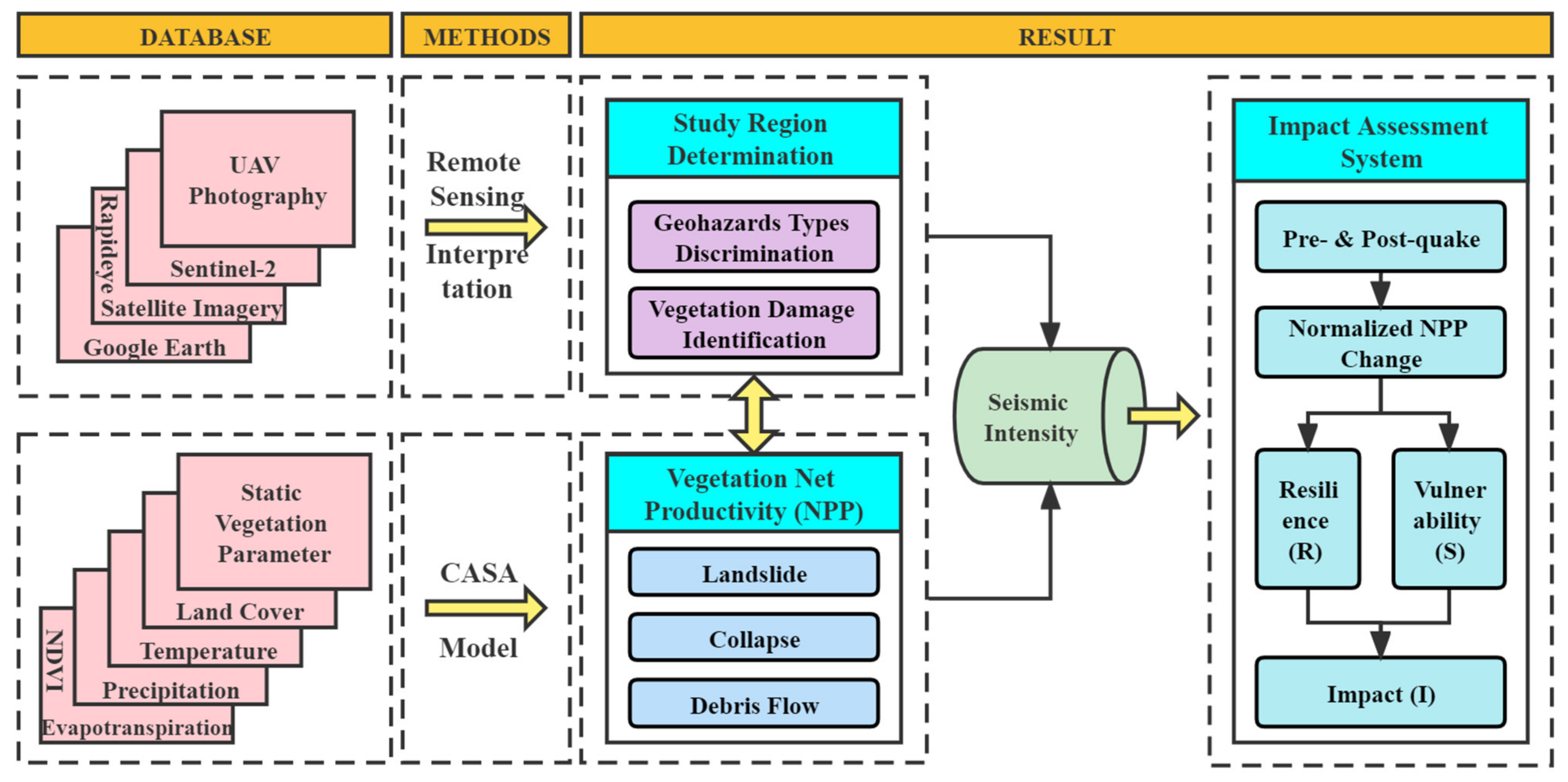
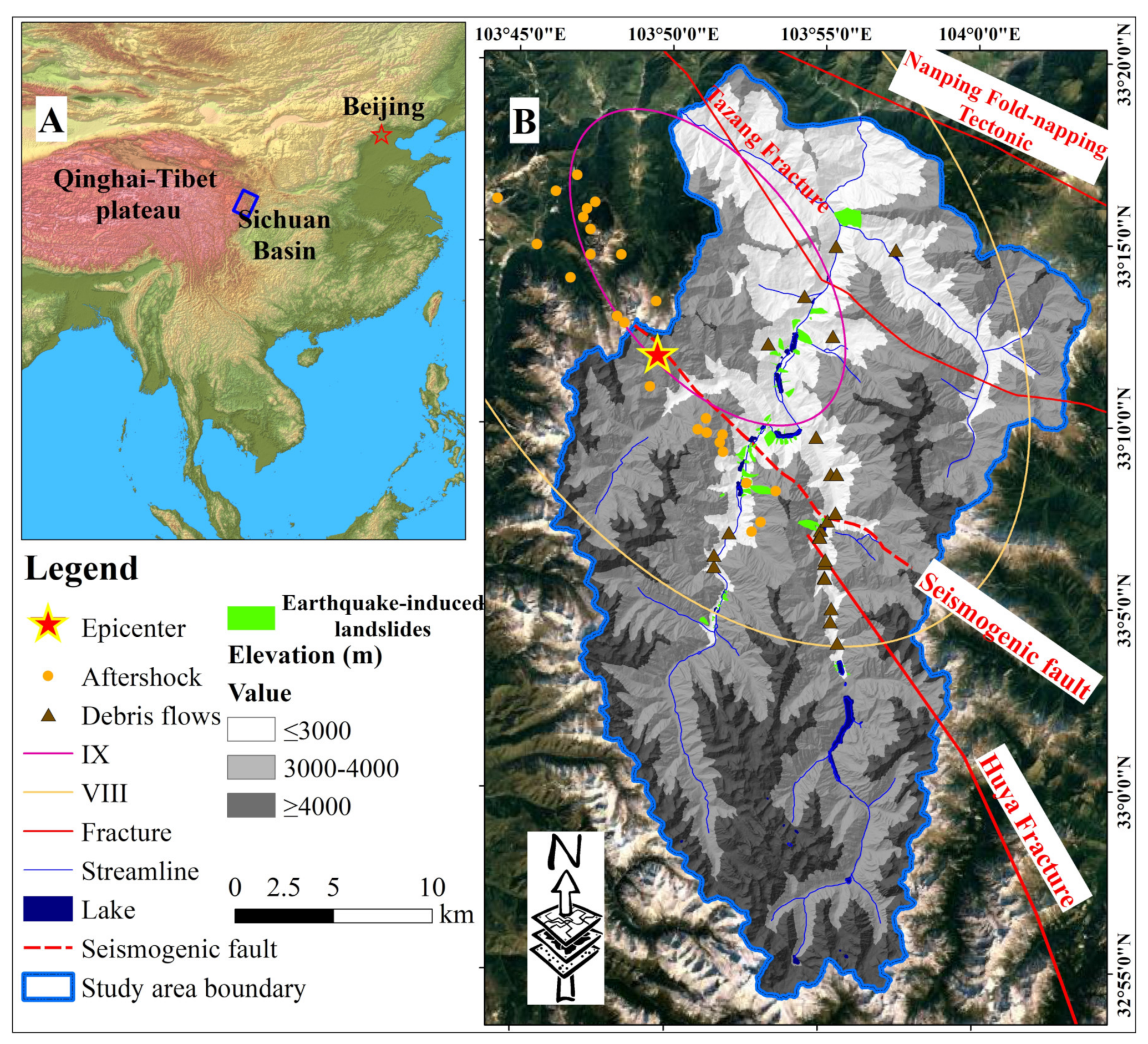
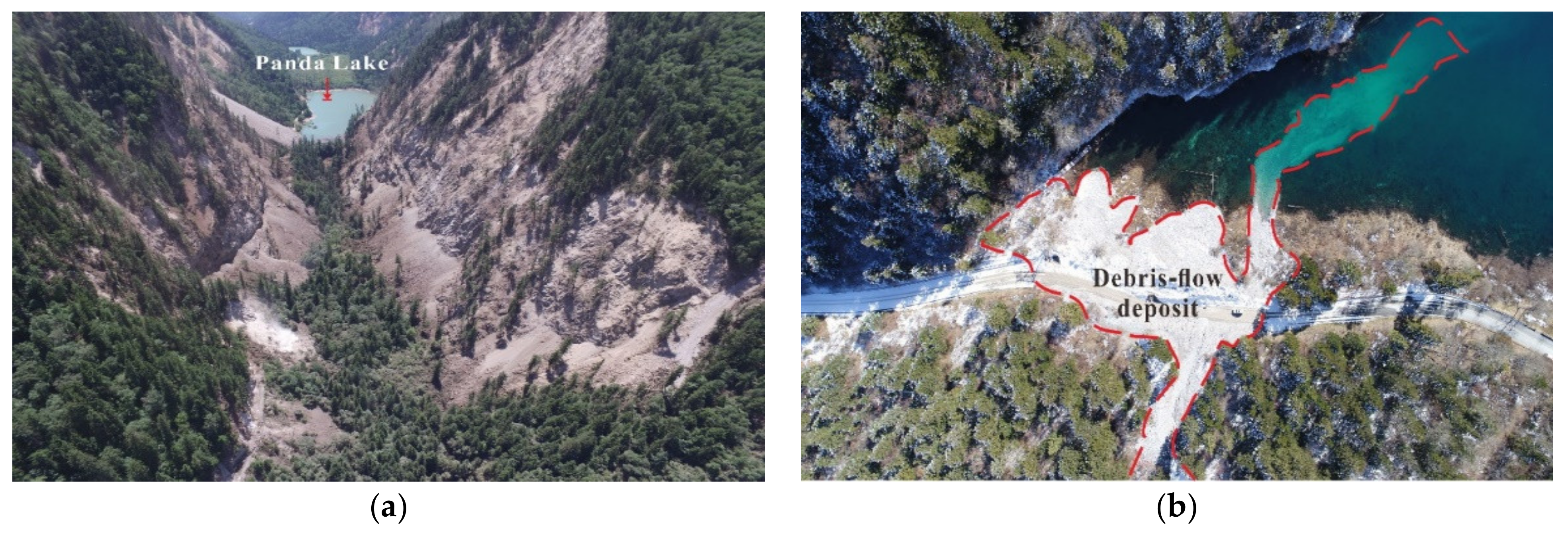


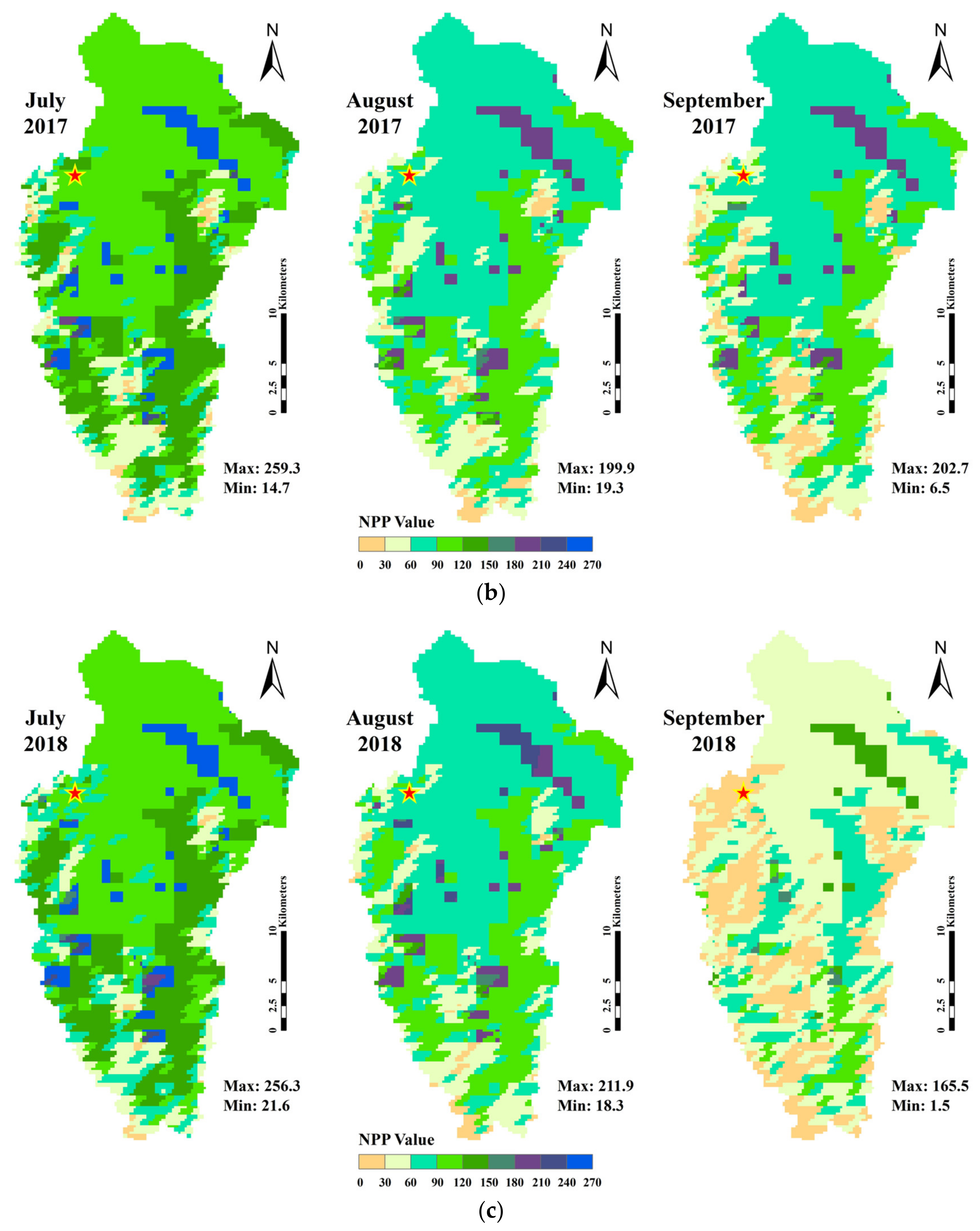

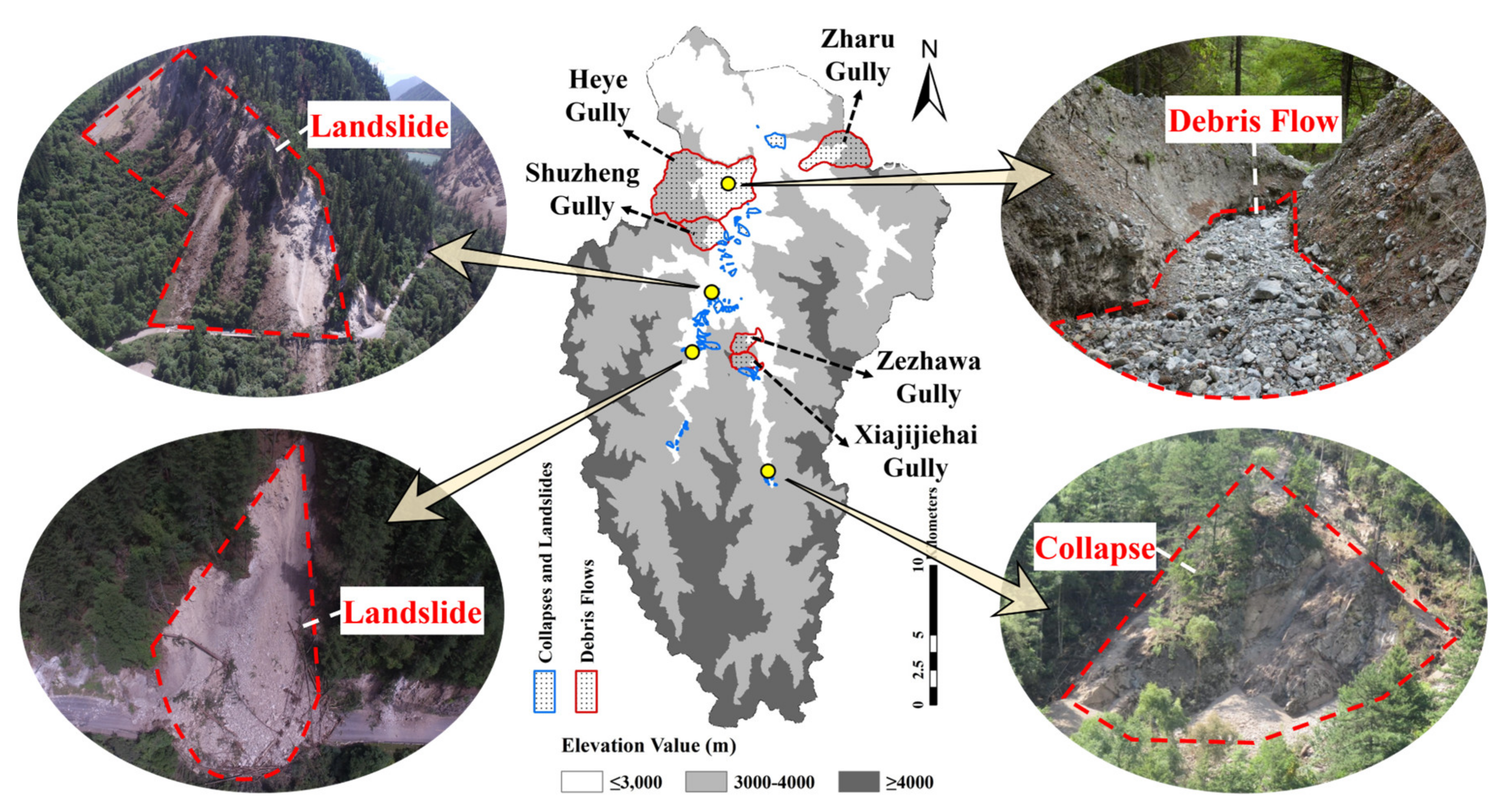

| Vegetation Type | SRmax | Εmax |
|---|---|---|
| Needleleaved deciduous forest | 6.63 | 0.485 |
| Needleleaved evergreen forest | 4.67 | 0.389 |
| Broadleaved evergreen forest | 5.17 | 0.985 |
| Broadleaved deciduous forest | 6.91 | 0.692 |
| Bush | 4.49 | 0.429 |
| Sparse woods | 4.49 | 0.542 |
| Alpine and sub-alpine grassland | 4.46 | 0.542 |
| Lake | 4.46 | 0.542 |
| Rock | 4.46 | 0.542 |
| NPP Value (gC/m2) | 2015 | 2016 | 2017 | 2018 | 2019 | |
|---|---|---|---|---|---|---|
| NPPmax | July | 260.3 | 239.1 | 259.3 | 255.3 | 231.3 |
| August | 250.9 | 209.2 | 199.9 | 211.9 | 261.9 | |
| September | 151.5 | 167.7 | 202.7 | 165.5 | 218.2 | |
| NPPmean | July | 116.3 | 107.0 | 111.8 | 112.8 | 102.4 |
| August | 105.1 | 92.1 | 86.2 | 92.7 | 115.8 | |
| September | 62.8 | 69.7 | 83.6 | 54.6 | 89.1 |
| Dur-quake | Seismic Intensity | Area Proportion for Normalized Values (%) | Vulnerability Index (S) | Impact Coefficient (I) | ||||
| 0–0.2 | 0.2–0.4 | 0.4–0.6 | 0.6–0.8 | 0.8–1 | ||||
| VII–VIII | 1.93 | 15.28 | 78.99 | 3.26 | 0.54 | 0.470 | 0.168 | |
| VIII–IX | 0.97 | 12.49 | 84.98 | 1.53 | 0.03 | 0.474 | 0.146 | |
| IX+ | 1.86 | 3.26 | 5.21 | 87.81 | 1.86 | 0.669 | 0.213 | |
| VII–IX+ | 1.21 | 13.23 | 83.53 | 1.81 | 0.22 | 0.473 | 0.156 | |
| Post-quake | Seismic Intensity | 0–0.2 | 0.2–0.4 | 0.4–0.6 | 0.6–0.8 | 0.8–1 | Resilience Index (R) | Impact Coefficient (I) |
| VII–VIII | 1.20 | 2.76 | 24.03 | 67.70 | 4.31 | 0.642 | 0.168 | |
| VIII–IX | 0.03 | 0.29 | 5.66 | 91.33 | 2.69 | 0.693 | 0.146 | |
| IX+ | 1.02 | 2.05 | 3.07 | 92.47 | 1.40 | 0.682 | 0.213 | |
| VII–IX+ | 0.39 | 1.32 | 13.38 | 82.23 | 2.68 | 0.671 | 0.156 | |
| Seismic Intensity | Area Proportion (%) | |||
|---|---|---|---|---|
| Dur-Quake | Post-Quake | |||
| NPP < 0 gC/m2 | NPP > 0 gC/m2 | NPP < 0 gC/m2 | NPP > 0 gC/m2 | |
| VII–VIII | 82.79 | 17.21 | 45.74 | 54.26 |
| VIII–IX | 94.84 | 5.16 | 19.78 | 80.22 |
| IX+ | 98.98 | 1.02 | 6.88 | 93.12 |
Publisher’s Note: MDPI stays neutral with regard to jurisdictional claims in published maps and institutional affiliations. |
© 2022 by the authors. Licensee MDPI, Basel, Switzerland. This article is an open access article distributed under the terms and conditions of the Creative Commons Attribution (CC BY) license (https://creativecommons.org/licenses/by/4.0/).
Share and Cite
Wang, C.; Hu, X.; Hu, K.; Liu, S.; Zhong, W. Impact Assessment of the Ms7.0 Earthquake on Jiuzhaigou Valley from the Perspective of Vegetation Net Primary Productivity. Sensors 2022, 22, 8875. https://doi.org/10.3390/s22228875
Wang C, Hu X, Hu K, Liu S, Zhong W. Impact Assessment of the Ms7.0 Earthquake on Jiuzhaigou Valley from the Perspective of Vegetation Net Primary Productivity. Sensors. 2022; 22(22):8875. https://doi.org/10.3390/s22228875
Chicago/Turabian StyleWang, Chenyuan, Xudong Hu, Kaiheng Hu, Shuang Liu, and Wei Zhong. 2022. "Impact Assessment of the Ms7.0 Earthquake on Jiuzhaigou Valley from the Perspective of Vegetation Net Primary Productivity" Sensors 22, no. 22: 8875. https://doi.org/10.3390/s22228875
APA StyleWang, C., Hu, X., Hu, K., Liu, S., & Zhong, W. (2022). Impact Assessment of the Ms7.0 Earthquake on Jiuzhaigou Valley from the Perspective of Vegetation Net Primary Productivity. Sensors, 22(22), 8875. https://doi.org/10.3390/s22228875







